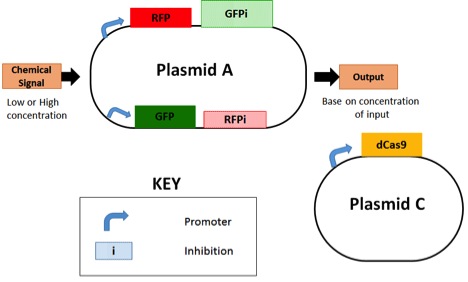Goals
A dark box can provide a sample with a 3-color luminous source.
The light intensity should be equal in samples.
The device should be easy to be assembled and operated.
The device should have expansibility.
Design
The luminous device is a bridge between electric parts and biological parts. In this project, we choose flasks as our sample container, LEDs as our luminous sources. Since the distribution of light intensity is not equal in entire space, we must chose a light direction. Side and top were finally abandoned because wall of flasks can reflect light so that the light intensity are not equal in samples.
After the direction, the distance between bottom and luminous should be decided. Distribution of light intensity close to LEDs is not equal. The range is fairly shape, but the range shinks with a longer distance. After 15cm, the distribution is mainly equal. 15cm is our final decision.
The dark box contains two parts. The upper part holds a flask and the downer part is empty. At the bottom of darkbox is a micro circuit board which contains some circuit components and three LEDs: red, green and blue. The LEDs can be controled by MCU(Microprogrammed Control Unit) via lines.
LED board
LED board contains basic circuit components which plays the terimal of control system. The board is tiny and easy to make that enhance the expansibility.
 Fig 2 circuit diagram of LED board
There are three kinds of circuit components on the board: adjustable resistors, audions and LEDs.
Adjustable resistors are used to keep the initial light intensity to be same. Audions are used to amplify the signal delivered from MCUs.
To make boards be easy to install, we put LEDs on one side and other components on the other side. Thus we can fix them at the bottom of dark boxes.
MCU part
MCU part translates the digital value into electronic signal. It has one COM port as input port and 8 PWM(Pulse Width Modulation) output port, each of them can adjust light intensity of one LED, so one board can control two 3-color LED boards.
One MCU can not meet our need, because two parallel experiments can show the differents among three genetic factors. In ideal situation, we need nine 3-color LED boards work at the same time. In other word, we need four MCU boards, and we finally use two as prototype.
Due to our modular design, the expansibility is fairly great, the LED boards can be changed with 1-color or 2-color boards, and the number of terimals doesn't have any limit with enough MCUs.
Next:[http://igem.bio-x.cn/Team:SJTU-BioX-Shanghai/Project/Luminous_device/Control Control]
|
 "
"
